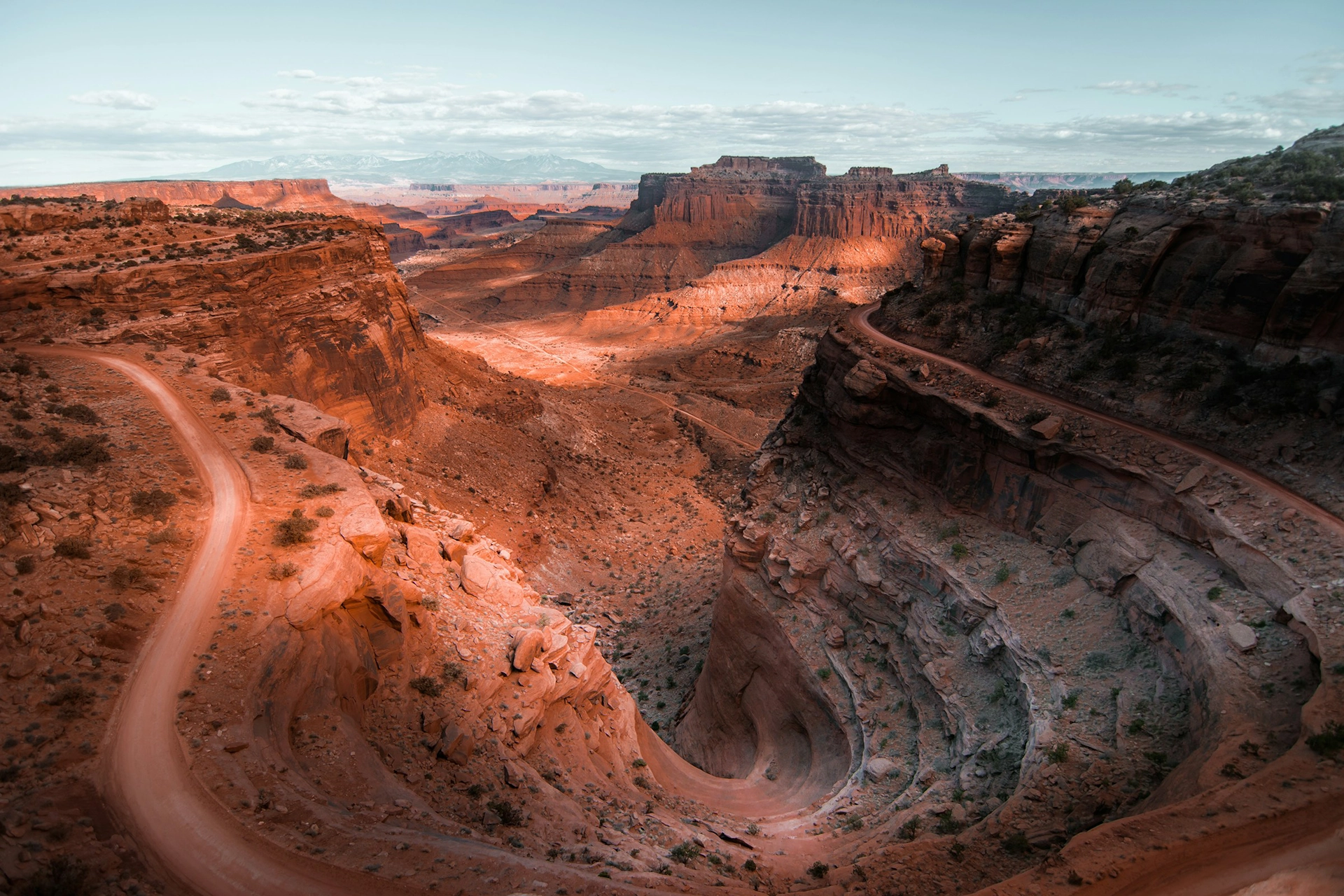An ATV creates a different relationship with terrain than any other machine. You're not enclosed in a protective shell like a Jeep, but you're also not limited to your own two feet like hiking. Instead, you exist in this middle ground where you can feel every bump, grade change, and texture shift through the handlebars while covering distances that would take hours on foot. The machine amplifies your senses rather than dulling them—wind carries scents of sage and sandstone, engine vibrations telegraph the character of the rock beneath your tires, and your body moves with the terrain instead of fighting against it.
Riding an ATV through Moab's red rock country isn't just transportation—it's a form of mechanical meditation that connects you directly to landscapes that have been shaping themselves for millions of years.
Why Moab Represents the Pinnacle of ATV Experiences
Moab didn't accidentally become the ATV capital of the American Southwest. The terrain here offers something you can't find anywhere else: incredible variety within a relatively compact area, combined with rock formations that seem specifically designed to challenge and reward ATV riders.
Slickrock surfaces that provide unmatched traction and unique riding dynamics
Multiple difficulty levels accessible from the same trailheads
Year-round riding seasons with each offering different trail conditions
Stunning visual payoffs that justify every technical challenge
Established trail systems with decades of sustainable use planning
Support infrastructure built around the ATV community
BLM land access providing hundreds of miles of legal riding opportunities
What Sets ATV Exploration Apart
ATVs occupy a sweet spot in off-road exploration that other vehicles can't match. You get the nimbleness to navigate tight technical sections that would challenge larger vehicles, plus the power and stability to handle terrain that would exhaust you on foot. The open-air experience means you're constantly aware of your environment—temperature changes, wind direction, the subtle sounds that indicate what type of rock you're crossing.
Immediate terrain feedback through handlebars and seat
Quick direction changes that allow creative line choices
Access to narrow trails impossible for larger vehicles
Enhanced sensory connection to weather and landscape
Individual pace control within group rides
Lower intimidation factor for beginners compared to larger off-road vehicles
Easier recovery when things don't go according to plan
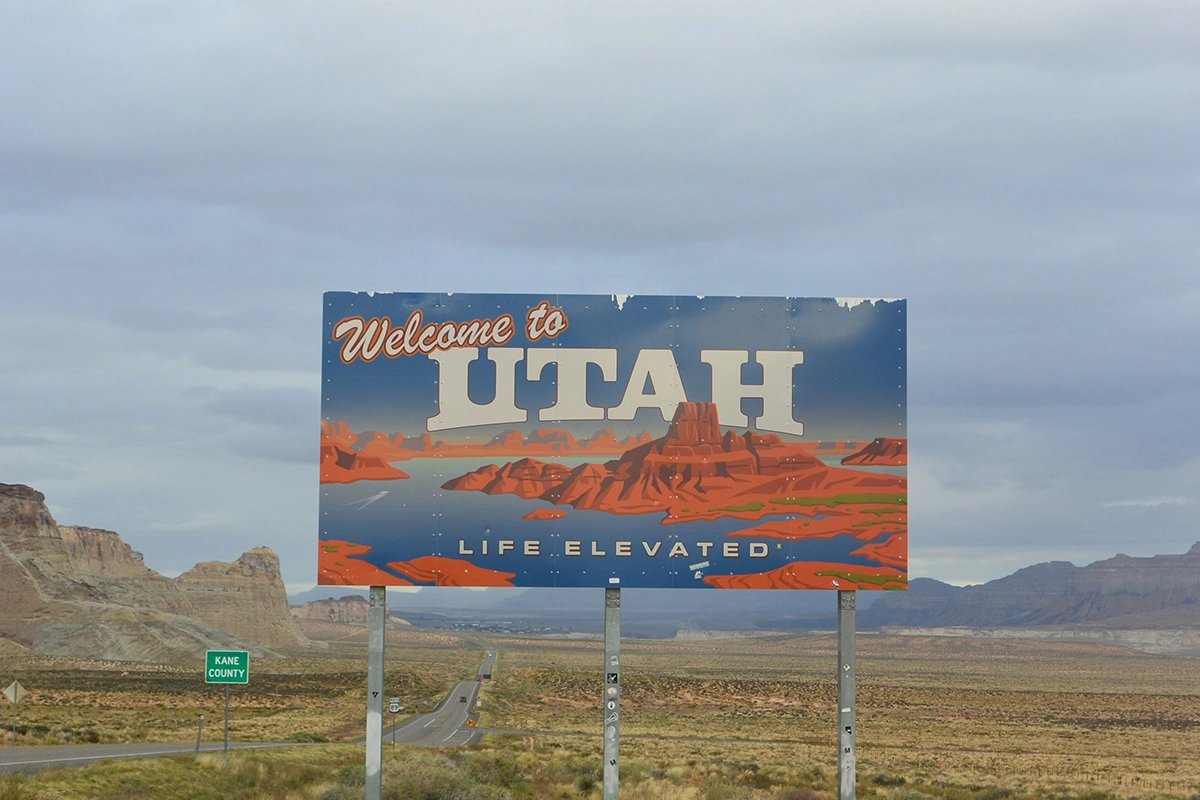
Understanding Moab's ATV Trail System
The trail network around Moab wasn't designed by committee or drawn on maps by people who never rode the terrain. Instead, it evolved organically over decades as riders discovered natural routes through the landscape, with official designations following the paths that actually worked. This means the trails feel intuitive rather than arbitrary—they follow the natural flow of the terrain and connect landscapes in ways that make sense once you're out there experiencing them.
Over 100 miles of designated ATV trails within 30 minutes of Moab
Interconnected route systems that allow multi-trail experiences in single rides
Natural progression from easier access routes to more challenging terrain
Scenic connectors that link technical sections with recovery areas
Multiple difficulty options from the same trailheads and parking areas
Loop trail opportunities that eliminate backtracking on familiar terrain
Land Management and Access Rights
The relationship between public land access and recreation around Moab operates on a system that balances conservation with recreational use. Understanding these boundaries matters because violating them can result in serious fines and potentially threaten future access for everyone.
BLM lands welcome ATV use on designated trails, while National Park boundaries are strictly off-limits to motorized vehicles—knowing the difference keeps you legal and helps preserve access for future riders.
Terrain Variety That Keeps Things Interesting
Slickrock domes - Sandstone surfaces with incredible traction and unique riding dynamics
Technical rock gardens - Boulder fields requiring precise line selection and throttle control
Sand washes - Flowing terrain that rewards momentum and teaches balance
Steep climbs and descents - Grade changes that test both rider skill and machine capability
Narrow slot passages - Tight technical sections demanding accuracy and confidence
Open mesa tops - High-speed cruising areas with panoramic views
Seasonal Trail Conditions and Timing
Spring (March-May) - Moderate temperatures, possible mud from snowmelt, wildflowers
Summer (June-August) - Hot conditions, afternoon thunderstorms, longest daylight hours
Fall (September-November) - Perfect temperatures, stable weather, golden light
Winter (December-February) - Cold mornings, possible snow/ice, shortest days but great solitude
The Bottom Line: Moab's trail system works because it developed naturally around what the terrain offered, not what planners thought should exist—which means every trail has a purpose and a personality that becomes obvious once you start riding.
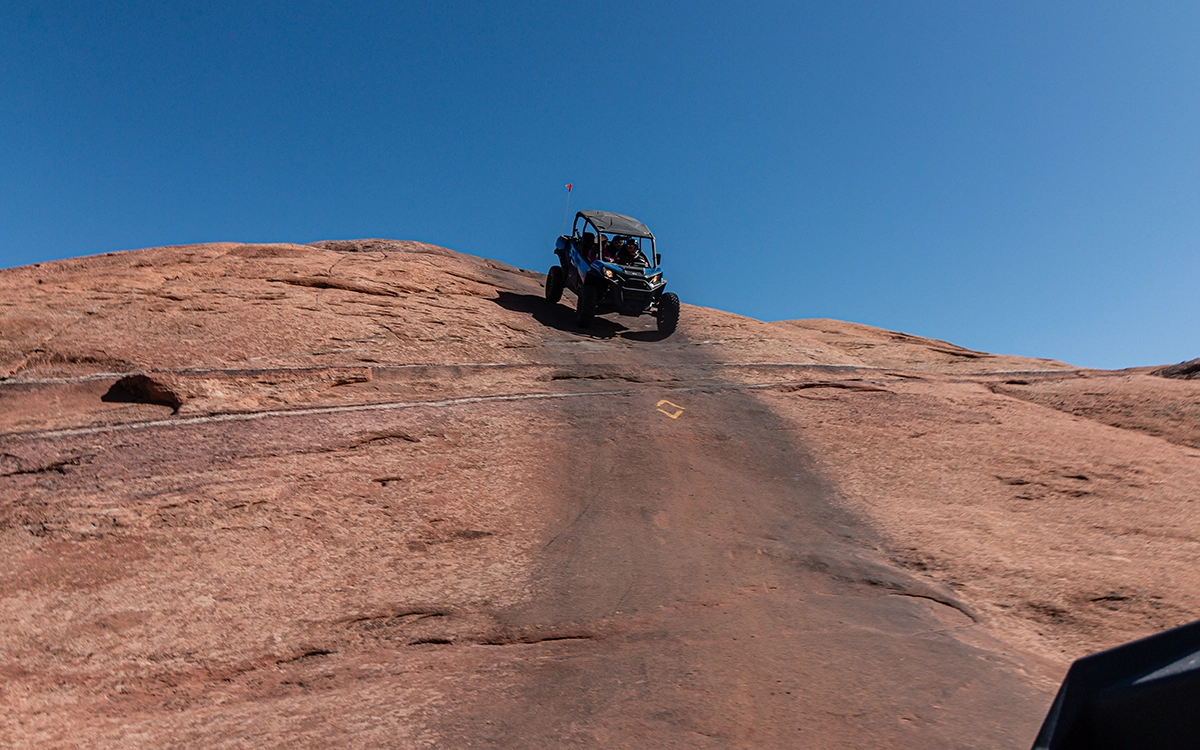
Trail Categories by Difficulty and Terrain Type
The beauty of Moab's trail system lies in how it accommodates every skill level without making anyone feel left out or unchallenged. Beginner trails aren't just easier versions of advanced routes—they're carefully designed experiences that teach fundamental skills while delivering genuine adventure. Advanced trails aren't just harder for the sake of being difficult—they reward technical proficiency with access to terrain that simply can't be experienced any other way.
Skill-appropriate challenges that push boundaries without creating dangerous situations
Progressive difficulty increases that allow natural skill development over time
Multiple route options from shared trailheads accommodating mixed-skill groups
Clear difficulty indicators based on actual terrain features rather than arbitrary ratings
Escape routes and bypasses that prevent riders from getting in over their heads
Natural teaching environments where mistakes have consequences but not catastrophic ones
Beginner-Friendly Routes That Actually Matter
These trails introduce you to ATV riding in Moab without throwing you into situations that exceed your current abilities. The goal isn't just to keep you safe—it's to build your confidence systematically while showing you why people become passionate about this activity.
Bartlett Wash - Smooth sand and gravel with gentle grades and wide turning areas
Courthouse Pasture - Open terrain with optional technical features you can choose to attempt
Mill Creek - Scenic route with water crossings and varied surface textures
Gemini Bridges approach - Moderate challenges with spectacular destination payoff
Lower Tusher Tunnel - Historic mining route with manageable technical sections
Kane Creek Boulevard - Paved and dirt sections following the Colorado River
Intermediate Trails for Skill Development
Intermediate routes bridge the gap between basic riding and technical mastery. These trails introduce concepts like line selection, momentum management, and reading terrain while still providing margin for error when you make mistakes.
Fins and Things - Slickrock introduction with optional challenging sections
Klondike Bluffs - Varied terrain types in a single ride with moderate exposure
Monitor and Merrimac - Natural arch destinations with technical approach routes
Corona Arch approach - Combination of different surface types leading to hiking access
Lone Mesa - Mesa-top riding with moderate climbs and descent challenges
Moab Rim lower sections - Technical preview of advanced terrain with escape options
Advanced Challenges That Demand Respect
Advanced trails around Moab don't just test your riding skills—they demand complete attention, precise technique, and honest assessment of your abilities. These routes reward experience and punish overconfidence, but they also provide access to terrain and views that justify every moment of concentration they require.
Hell's Revenge complete loop - Classic slickrock with exposure and mandatory technical features
Poison Spider Mesa - Steep climbs, narrow passages, and commitment-required sections
Golden Spike - Remote technical riding with navigation challenges
Moab Rim full route - Exposed climbing with significant consequences for mistakes
Pritchett Canyon - Rock crawling that tests both machine capability and rider skill
Metal Masher - Technical descents and climbs requiring advanced line selection
Specialty Terrain Types
Each terrain type around Moab teaches different lessons and rewards different approaches. Slickrock demands trust in traction that seems impossible until you experience it. Sand washes reward smooth throttle control and momentum management. Technical rock gardens require patience, precision, and the ability to read three-dimensional puzzles while moving. Understanding these different terrain personalities helps you choose routes that match both your skill level and your desire for specific types of challenges.
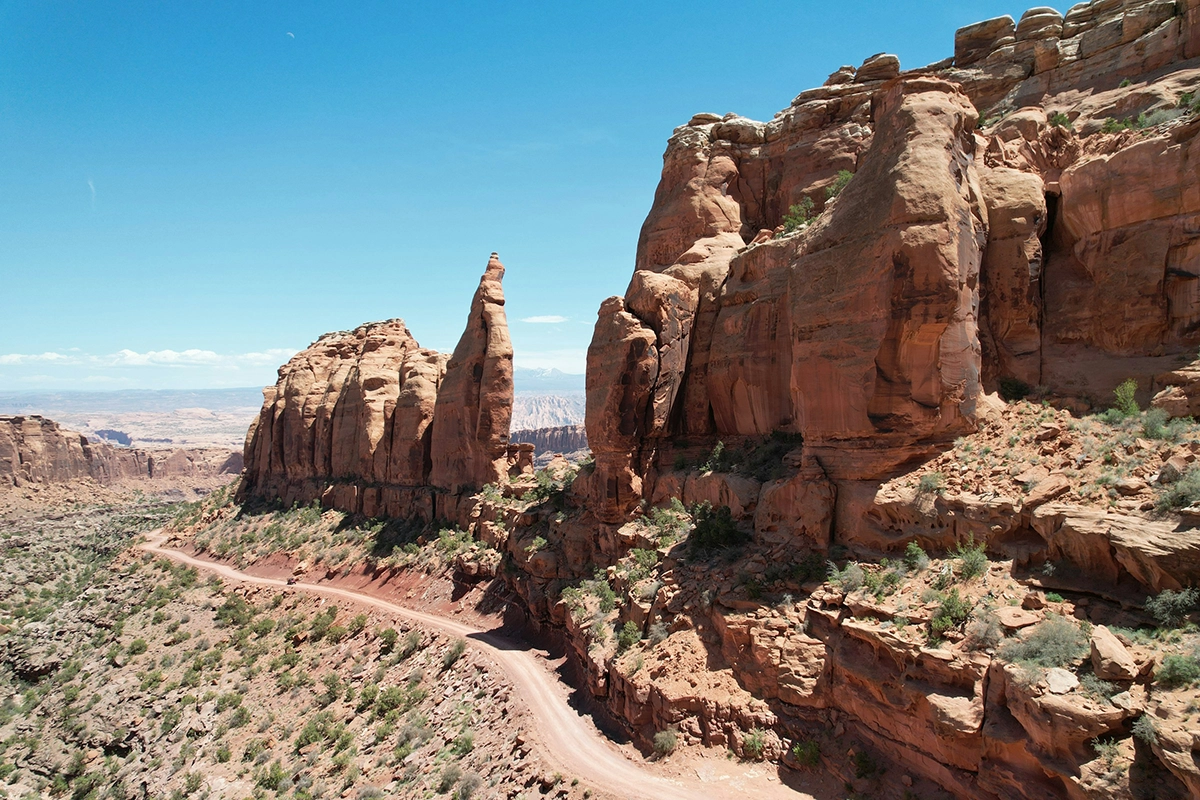
Specific Trail Recommendations
Talking about trails in general terms only gets you so far—at some point, you need specific recommendations that match real riding conditions and actual difficulty levels. These six trails represent the essential Moab ATV experience, covering everything from family-friendly exploration to serious technical challenges. Each offers something unique, and together they provide a complete education in what makes riding around Moab special.
Hell's Revenge - The trail everyone talks about for good reason
Fins and Things - Where technical riding starts making sense
Poison Spider Mesa - Spectacular views earned through genuine challenge
Klondike Bluffs - The trail locals ride when they want variety
Bartlett Wash - Perfect introduction for riders of all ages
Behind the Rocks - Technical mastery in a stunning natural amphitheater
Hell's Revenge: The Classic Slickrock Experience
Hell's Revenge built its reputation honestly—it delivers everything people expect from Moab slickrock riding while remaining accessible to intermediate riders who approach it with appropriate respect. The trail follows natural sandstone domes and bowls, creating a roller-coaster experience that feels simultaneously thrilling and manageable. What makes this trail special isn't just the technical features—it's how the route flows naturally through the landscape, creating an experience that feels like the terrain designed it specifically for ATV riding. The views from the higher sections stretch across the entire Moab valley, providing context for the smaller trails you can see threading through the red rock formations below. This trail requires commitment once you start the technical sections, but it rewards that commitment with an experience that explains why people travel from around the world to ride ATVs in Moab.
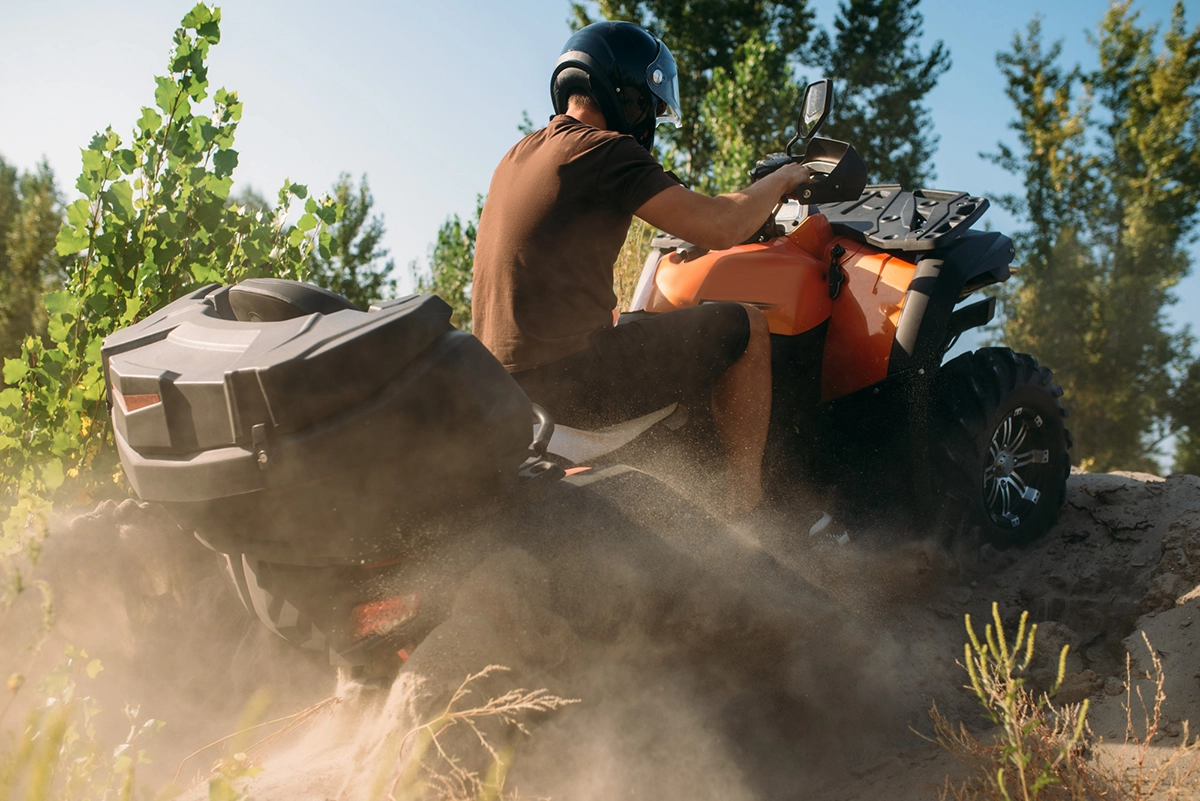
ATV vs. UTV: Choosing Your Machine
The choice between an ATV and a UTV isn't just about personal preference—different machines excel in different situations, and understanding these differences helps you choose the right tool for the type of experience you want. Both have their place in Moab's terrain, but they create fundamentally different relationships between rider and landscape.
When ATVs Excel Over Side-by-Sides
ATVs shine in situations where nimbleness, individual control, and direct terrain connection matter more than comfort and cargo capacity. The learning curve is gentler, the consequences of mistakes are typically less severe, and the overall experience feels more intimate.
Narrow technical sections where width restrictions favor single-track vehicles
Steep climbs and descents where weight distribution and balance matter most
Tight maneuvering situations requiring quick direction changes and precise placement
Solo riding experiences where individual pace and line choice take priority
Budget-conscious adventures with lower rental costs and fuel consumption
Learning environments where mistakes teach lessons without major consequences
Weather flexibility with better performance in varied conditions
Terrain Considerations for Vehicle Selection
Different terrain types favor different machines, and Moab offers enough variety that this choice actually matters. Slickrock generally favors ATVs because of their superior weight distribution and agility. Sand washes work well for both, but ATVs offer more precise throttle control for momentum management. Technical rock gardens often require the nimbleness that only ATVs provide, while open mesa riding might favor the comfort and stability of UTVs for longer distances.
Group Dynamics and Vehicle Choice
Group composition often determines the best vehicle choice as much as terrain considerations do. Mixed-skill groups benefit from ATVs because they're more forgiving and allow individual pace control without holding up others. Families with younger riders often prefer ATVs for their lower intimidation factor and easier learning curve. Groups focused on covering long distances might choose UTVs for comfort, while those prioritizing technical challenges usually gravitate toward ATVs for their superior maneuverability.
Cliffhanger's Fleet Options
Cliffhanger maintains both ATV and UTV fleets because they understand that different adventures call for different machines. Their ATV selection focuses on reliable, well-maintained models that can handle Moab's technical terrain without breaking down when you're miles from the nearest road. Each machine receives thorough pre-rental inspection and comes equipped with basic safety gear and recovery equipment. Their team can help match you with the right machine based on your experience level, intended routes, and group dynamics rather than just pushing whatever happens to be available.
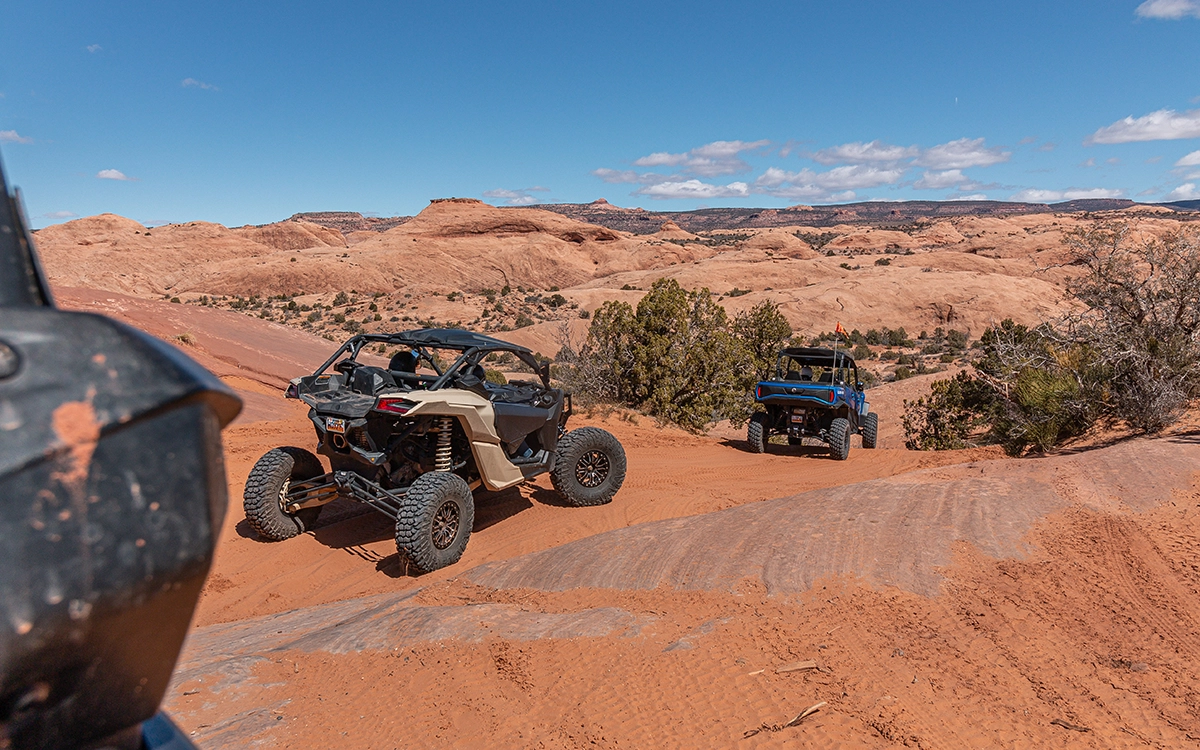
Practical Preparation and Safety
Safety in ATV riding isn't about avoiding all risks—it's about managing them intelligently so you can focus on enjoying the experience rather than worrying about what might go wrong. The difference between a great adventure and a costly mistake often comes down to simple preparation and understanding how your decisions affect both your safety and that of other riders sharing the trails.
Quality helmet and eye protection - Non-negotiable basics that protect your most vulnerable areas
Long pants and closed-toe shoes - Minimum clothing for leg and foot protection
Gloves with good grip - Better control and protection from blisters and impacts
First aid kit with basics - Bandages, pain relievers, and emergency contact information
Extra water and snacks - More than you think you'll need for longer rides
Multi-tool or basic repair kit - Simple fixes that prevent long walks back to town
Emergency whistle - Backup communication when other methods fail
Cash for permits and fees - Many areas still operate on cash-only systems
Weather Impact on Trail Conditions
Moab's desert environment creates weather patterns that can dramatically change trail conditions within hours. What looks like perfect riding weather in town might be completely different at higher elevations or in exposed areas. Rain transforms some trails from manageable challenges into dangerous mud bogs, while extreme heat makes metal surfaces untouchable and increases dehydration risks exponentially.
Remember: Weather in the desert isn't just about comfort—it directly affects trail safety, traction, and visibility in ways that can turn familiar routes into serious challenges.
Navigation and Trail Responsibility
Modern GPS systems make it easier than ever to stay on designated trails, but technology isn't foolproof and batteries don't last forever. Understanding how to read trail markers, carry backup navigation tools, and recognize when you've wandered off-route protects both you and the fragile desert environment that makes these trails possible.
Download offline maps before leaving cell service areas
Carry paper maps as backup for when electronics fail
Understand trail marking systems used in the Moab area
Recognize boundary signs that indicate restricted areas
Stay on established trails to protect fragile desert ecosystems
Report trail damage or illegal riding to help preserve access for everyone
Group Riding Protocols
Riding in groups amplifies both the fun and the potential for problems. Good group protocols prevent accidents, keep everyone together, and make sure the experience works for riders of different skill levels. The goal is creating an environment where everyone can challenge themselves appropriately without being pushed beyond their comfort zone or holding back others who want to tackle more difficult sections.
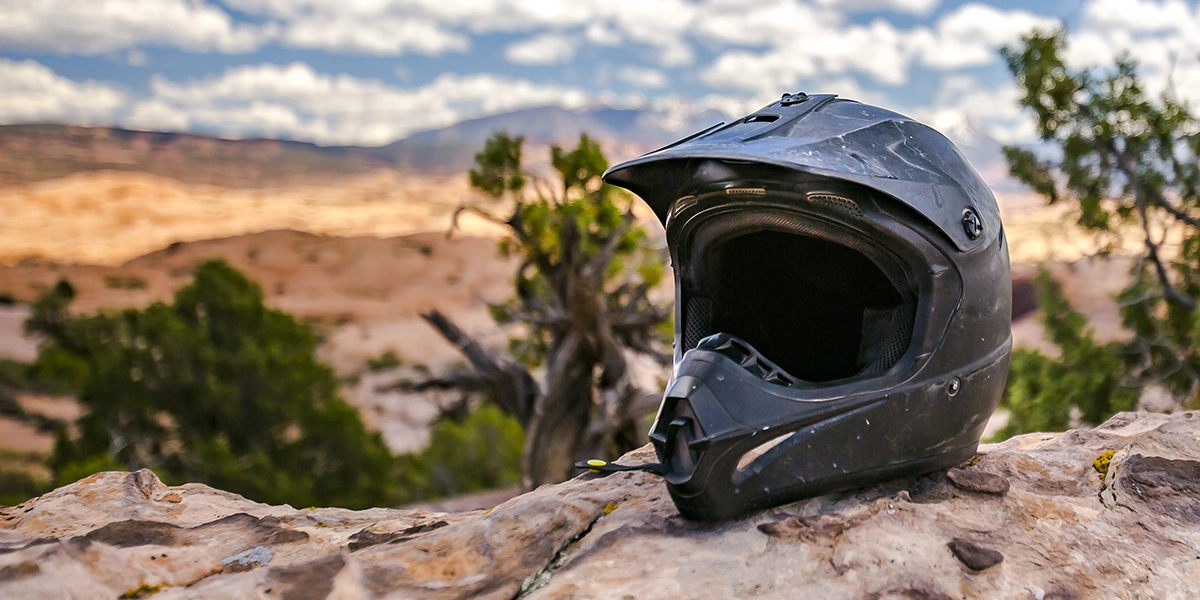
The Cliffhanger Advantage for ATV Adventures
Most ATV rental companies treat their machines like disposable tools and their customers like anonymous transactions. Cliffhanger operates differently because they understand that your experience depends entirely on the quality of your equipment and the knowledge behind your rental. When you're miles from the nearest road on technical terrain, the difference between a well-maintained machine and a barely functioning one becomes the difference between an adventure and a rescue situation.
Fleet Specifications and Maintenance Standards
Cliffhanger's ATV fleet consists exclusively of machines built to handle Moab's demanding terrain on a daily basis. Each machine receives comprehensive inspection before every rental, not just when problems arise. The maintenance schedule exceeds manufacturer recommendations because the consequences of mechanical failure in remote areas are too serious to accept unnecessary risks.
Daily pre-rental inspections covering brakes, throttle response, and safety equipment
Preventive maintenance schedules that exceed manufacturer recommendations
Performance modifications specifically chosen for Moab terrain characteristics
Quality replacement parts rather than budget alternatives that fail under stress
Emergency repair capabilities for field fixes when problems occur on trails
Fleet rotation systems that prevent overuse and maintain peak performance
Detailed maintenance logs tracking each machine's history and performance patterns
Local Route Knowledge That Actually Matters
Cliffhanger's team doesn't just rent machines—they ride these trails regularly and understand how conditions change seasonally, which routes work best for different skill levels, and where the real challenges and rewards lie. This knowledge comes from years of experience guiding riders through terrain that can be unforgiving to those who don't understand its subtleties. They'll match you with routes that challenge you appropriately while avoiding situations that exceed your current abilities, because their reputation depends on your success rather than just getting you out the door with a rental agreement.
Flexible Rental Options for Real Adventures
Adventure doesn't operate on rigid schedules, and Cliffhanger's rental policies reflect this reality. They offer the longest rental days in Moab because they understand that the best experiences often happen when you're not watching the clock. Whether you want to catch sunrise from a remote overlook or need extra time to work through a challenging technical section, their flexible approach lets you experience the terrain on its own terms rather than rushing to meet arbitrary return times.
Support and Emergency Assistance
When you're exploring remote terrain, knowing that competent help is available if things go wrong provides peace of mind that lets you focus on enjoying the experience. Cliffhanger maintains emergency support capabilities and communication protocols that can reach you in areas where cell phones become expensive paperweights. Their team knows the trail system well enough to find you quickly when problems arise, and they have the equipment and expertise to handle both mechanical issues and emergency situations.
Choosing Cliffhanger means partnering with people who understand that your adventure's success depends on equipment reliability, local expertise, and support systems that work when you need them most—not just when it's convenient.
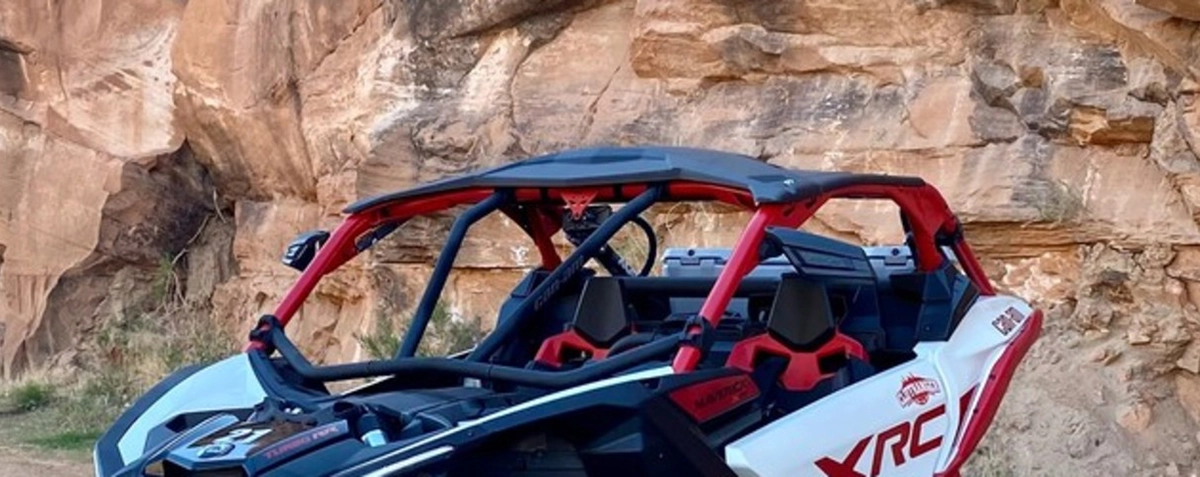
What Makes Moab ATV Riding Transformative
Most people arrive in Moab expecting to ride some trails and see some scenery. What they don't expect is how the experience quietly rearranges their relationship with both challenge and landscape. The transformation happens gradually, almost without notice, until you realize that technical terrain no longer intimidates you the way it used to, and problems that seemed overwhelming before now feel manageable within a larger context.
The Meditative Aspects of Technical Trail Riding
Technical ATV riding demands complete presence in a way that few activities can match. Your attention consolidates into the immediate moment—reading the terrain ahead, feeling traction feedback through the handlebars, and making constant micro-adjustments that keep you balanced and moving forward. This isn't meditation in the traditional sense, but it creates the same mental state: focused awareness where distracting thoughts disappear because the immediate task requires everything you have. The engine noise fades into background hum, your breathing synchronizes with the terrain's rhythm, and time passes without your notice because you're completely absorbed in the conversation between your machine and the rock beneath it.
How the Landscape Changes Your Perspective on Challenges
When you successfully navigate terrain that initially seemed impossible, something shifts in how you approach other challenges in your life. Not because ATV riding is some metaphor for overcoming obstacles, but because the experience provides concrete evidence that things that look overwhelming from a distance often become manageable when you break them down into smaller, immediate decisions. The landscape around Moab operates on a scale that puts human problems into perspective without minimizing their reality—your mortgage payment is still real, but it exists within a much larger framework of time and possibility.
The Community Aspect of ATV Culture in Moab
Moab's ATV community operates on principles that seem almost quaint in our current world: people help strangers without expecting anything in return, share information freely, and genuinely care about preserving access for future riders. This isn't because ATV riders are inherently better people—it's because the terrain creates situations where cooperation becomes more valuable than competition. When someone breaks down on a remote trail, politics and personal differences become irrelevant because getting everyone home safely takes priority over everything else.
Why Riders Return Year After Year
People return to Moab not just because the trails are fun, but because the landscape reveals different aspects of itself depending on your skill level, the season, and your willingness to explore beyond the obvious routes. Each visit builds on previous experiences, creating a deeper understanding of both the terrain and your own capabilities. The trails that challenged you last year become stepping stones to more demanding routes this year, while familiar trails reveal details you missed when you were focused on just getting through them successfully.
Moab ATV riding changes people because it provides genuine challenges in an honest environment where skill, preparation, and good judgment matter more than luck or wishful thinking.
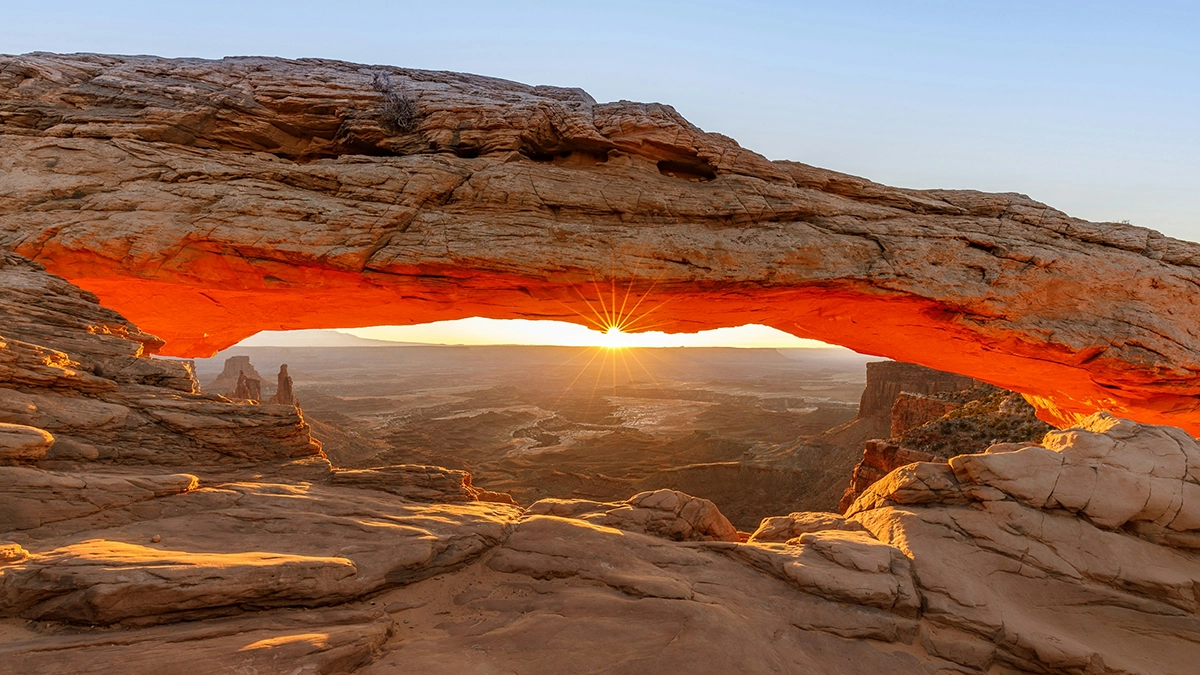
Planning Your Moab ATV Adventure
The conversation between you and Moab's terrain starts with a simple decision: booking your ATV rental and committing to the experience. Cliffhanger Jeep Rental makes this process straightforward because they understand that planning should build excitement rather than create obstacles. Their online booking system shows real-time availability for both ATVs and UTVs, and their team stands ready to help match you with the right machine and routes for your skill level and adventure goals.
Peak season demand means that waiting until the last minute often results in disappointment or settling for equipment that doesn't match your intended experience. Spring and fall see the highest demand for quality ATVs, while summer offers longer days and more availability at the cost of dealing with desert heat. Winter provides solitude and crisp riding conditions for those willing to accept shorter days and unpredictable weather.
Contact Cliffhanger directly for customized experiences that go beyond standard rental packages. Their team can design multi-day adventures, arrange group accommodations, and provide the local knowledge that transforms a simple trail ride into a genuine exploration of what this landscape offers. Whether you're planning a bachelor party adventure, introducing family members to ATV riding, or testing your skills against Moab's most challenging terrain, they'll create an experience that matches your specific goals rather than pushing a one-size-fits-all package.
Share your adventure on social media and tag @cliffhangerjeeprental to become part of the larger conversation about why this terrain matters and how it changes people who experience it properly. Your photos and stories inspire others to discover what Moab's trails can teach them about both technical riding and their own capabilities.
The red rock trails are waiting, and the transformation begins the moment you feel that first vibration of slickrock texture through your ATV's handlebars.


